“Think about a LinkedIn or Shutterstock employee,” says Thomas Durels, executive vice president, chief of property operations and leasing for Empire State Realty Trust. “Those are our tenants; they’re working at the Empire State Building any time, day or night. They’re traveling to and from restaurants, a fitness center, conference space, and their workspaces – all under one roof. We’re contributing to their productivity by making sure they don’t have to wait in line for an elevator as part of our goal to fully modernize and redevelop the world’s most famous office building.”
Durels says Empire State Realty Trust made the decision to renovate the elevators as part of the Empire State Building Rebuilding Program to provide fast, efficient, reliable transportation for tenants. The building’s elevator equipment had gone through some upgrades since it was constructed in 1930s; however, some components, such as the elevator shafts, hadn’t been touched at all. Along with rebuilding and restoring the shafts, the modernization team is also replacing the mechanical and electrical systems that work with and feed the new elevator equipment.
“Traveling on an elevator that’s 25% to 40% more efficient – and also reduces wait times – helps create the state-of-the-art corporate campus experience we want to provide,” says Durels. By improving total time to a destination, especially for tenants who use an elevator six or seven times per day, an elevator system can make a positive impact on workforce efficiency. Not only will the Empire State Building’s new Otis elevators improve system performance, but they will also improve ride quality, with less vibration and better, smoother acceleration and deceleration.
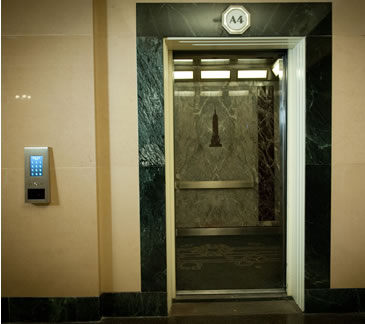
As part of its rebuilding program, the Empire State Building is in the midst of a complete elevator modernization that helps contribute to the efficiency of the facility’s tenants. (Image courtesy of Otis)
Although creating a better tenant experience was Durels’ motivation, Michael Lagana, project manager for Lerch Bates, says he works with building owners who decide to invest in elevator modernization projects for other reasons as well. “Most building owners take elevators for granted until they become a liability or are cited and require some sort of code-compliant upgrade.” For buildings that need a modernization to in order meet code, it can also be a good time to consider investing in new vertical transportation technology.
Lagana says that he has seen two recent modernization projects – the Wells Fargo Building in downtown Tampa, FL, and 150 Second Avenue in St. Petersburg, FL – involving building owners who initially wanted to modernize elevators to meet code. Once they learned about new elevator technology that can increase leasing and add value, they decided to take advantage of the situation and also invest in new technology to boost lease rates and tenant satisfaction levels. (See Take Tenants for a Ride with New Technology, below.)
The state of the vertical transportation industry is another reason building owners are choosing to upgrade elevators. “Elevator mechanics are retiring, and the industry is running lean. There isn’t a lot of time spent training new mechanics on old equipment,” explains Lagana. “The more experienced mechanics who entered the field back in the ‘70s and ‘80s are now exiting, which leaves a lot of older elevator equipment that newer technicians don’t really know how to repair or maintain. And this can result in poor system reliability.” Today, elevator companies are spending their training dollars on preparation for up-and-coming technology, not decades-old systems.
Energy efficiency is also driving some owners to make elevator modernization a priority. “Specifically in high-rises, new Power Factor 1 regenerative drive technology can improve the energy efficiency of your elevator by anywhere between 25% and 40%, depending on which system you currently have,” says Bill Lippman, vice president of modernization sales for Schindler Elevator Corp. Add in a newer AC gearless machine to replace the old DC, and that can add another 6% or 7% to energy savings.
“For the last 20 years, we’ve used brake-resistant drives, which weren’t very energy efficient,” explains Lippman. “Before that, we were using even older motor generators. So when you go from a motor generator to a brake-resistant solid state drive to a new Power Factor 1 drive with a new AC gearless machine, building owners are saving up to 60% in elevator energy costs.”
Aside from improving performance, Durels estimates that the Empire State Building’s new elevators will reduce total elevator energy consumption by as much as 30%.
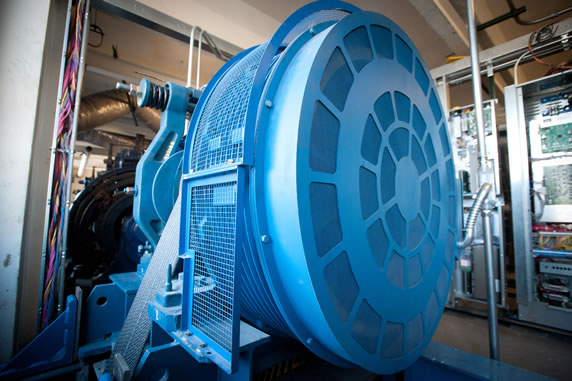
Along with rebuilding and restoring elevator shafts, the Empire State Building’s elevator modernization team is replacing the mechanical and electrical systems that work with and feed the new elevator equipment. Thomas Durels, executive vice president, chief of property operations and leasing for Empire State Realty Trust, estimates that the building’s new elevators will reduce total elevator energy consumption by as much as 30%. (Image courtesy of Otis)
Budgeting for a Modernization
As Durels can attest, a high-rise elevator modernization typically involves much more than just modernizing the elevator system.
“It’s a complicated process that also encompasses HVAC, electrical, and fire and life safety systems,” explains Lagana. As the building gets bigger and taller, the integration of those building systems becomes more complex to coordinate and budget for.
When building owners and managers budget for elevator modernization projects, the most common mistake is neglecting to save and estimate for this associated building-related work. When possible, Lagana recommends working with the “incumbent providers” (the HVAC, fire and life safety, and electrical companies already offering services to the building). “If you use a company that doesn’t already have a service or maintenance contract with your building, you usually don’t get good scheduling and delays can happen,” explains Lagana. Existing providers are already familiar with the building, too, which can help the project run faster and smoother.
Tips from the Pros
For Durels, the Empire State Building’s successful elevator modernization project (which began in 2011 and is still under way) comes down to four factors: upfront and careful planning, working closely with the manufacturer and consultant, timing of the project, and around-the-clock labor to get the work done.
“All that engineering and planning results in a greater ability to execute with certainty,” says Durels. “Right now, we’re working double-shift six days a week. And we’re looking at moving to triple-shift and working 24/7.” Because the bulk of the building’s new leases aren’t yet occupied – tenants are still building out their spaces – timing worked well for the team. Rather than put the modernization off, they decided to complete it as early as possible to cause a minimal amount of disruption to existing tenants. (It also didn’t hurt that the building was over-elevatored to begin with, which means that tenants aren’t greatly inconvenienced by out-of-commission elevators.)
From start to finish, developing a clear channel of communication with tenants about the project is another key component. “The most successful modernizations occur when everybody understands the investment the building owner is making to benefit the tenants. Sometimes modernizations can be a little strenuous on everybody, but if tenants understand what’s happening and why, they’ll be much more tolerant,” advises Lippman.
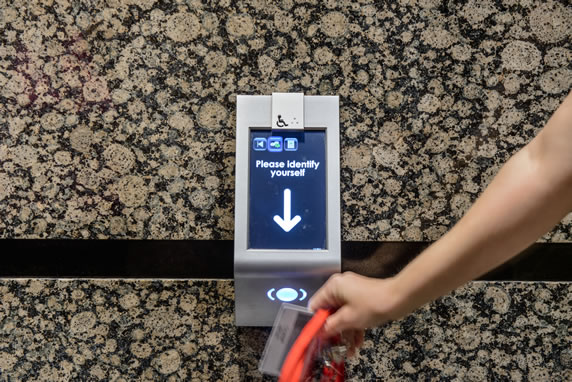
Access control can be built into destination-based elevator controls, helping building owners manage who has access to which floors for security purposes. (Image courtesy of Schindler)
Communicate about elevators that may be out of service. “Depending on how many elevators you have in a building, taking down an elevator can represent anywhere from 15% to 30% of the original capacity of the system,” explains Lippman.
Clear tenant communication also helps in managing the noise and disruption that comes with a modernization project. The more work that can be done during regular business hours, the less the project will cost in most cases; communicating this to tenants may help them be more understanding about enduring noise during the day.
It’s also important to know what the tenants’ contract language says about noise. “Most contracts state that there can’t be any construction noise from 8am to 5pm, for example,” says Lagana. “An elevator modernization isn’t constant noise, but there will be sporadic noise. And in a lot of older buildings, construction noise resonates. The larger and taller the building, the worse it tends to be.” For example, core drilling on the 35th floor will most likely be heard by tenants and visitors in the ground-floor lobby.
To avoid a problem, it’s best to identify tasks early on that will cause a lot of noise; then investigate pricing for getting that work done afterhours, or include that stipulation in the base bid for the project.
“To us, it’s all about leasing up the space and improving our rents,” says Durels. “We’re having excellent leasing success, and that’s how we measure the success or return on our elevator modernization project: by our lease up, increased rents, and tenant satisfaction and renewal of existing tenants.”
Take Tenants for a Ride with New Technology
In this highly competitive marketplace, if building owners are already spending a certain amount of money to upgrade elevators, Lerch Bates Project Manager Michael Lagana says it often makes sense to spend a little more to receive the latest and greatest technology.
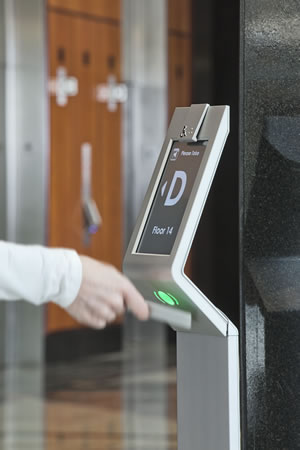
With destination-based controls, the elevator’s push buttons are essentially touchpads that tell building tenants which elevator to use based on current wait and travel times. (Image courtsey of Schinlder)
Destination-Based Controls
“Everybody has a touchscreen phone; with destination-based controls, the elevator’s push buttons are basically touchpads that tell tenants which elevator to use based on current wait and travel times,” he explains. Lagana says he’s seeing an increase in high-rise building owners who are writing specifications to include this technology.
Bill Lippman, vice president of modernization sales for Schindler Elevator Corp., says that several high-rises across the country are investing in destination-based controls as part of their elevator modernization projects, including:
- PPG Place in Pittsburgh
- Fifth Avenue Place in Pittsburgh
- One Worldwide Plaza in New York City
- One California Plaza in Los Angeles
- 388 Market Street in San Francisco
- Capital Bank Plaza in Raleigh, NC
- Three Lakeway Center in New Orleans
- 444 North Michigan in Chicago
Built-In Monitors
A newer technology in high-rise vertical transportation systems is incorporating flat-screen monitors inside the elevator cab. These monitors incorporate the elevator’s positioning indicator (which tells the rider where the elevator is and which direction it’s going), stream live television, and feature advertisements.
“Smart management companies are selling advertising on these monitors so that, instead of looking down at their phones, people in the elevator are looking at the monitors because it’s something different to watch and listen to,” explains Lagana. He says he has seen some building managers who are able to pay a large portion of their elevator maintenance bills from the revenue they receive through the advertising, providing a fast return on investment.
Another trick many building owners are using: If potential tenants are coming in to see available space, their names and company logo are uploaded onto the monitors, along with a welcome message. “This way, when they’re riding the elevator to get to the space, they feel at home,” says Lagana.
Originally published January 23, 2014


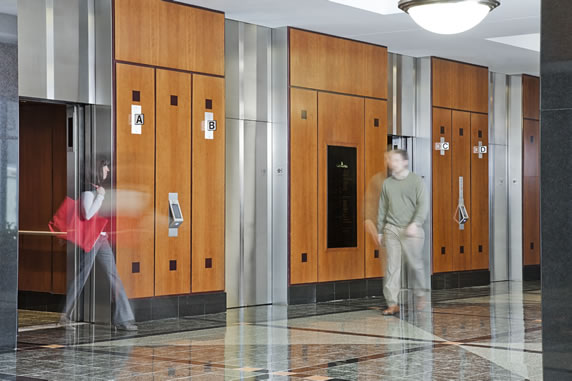
 An award winning editor, Leah spent over eight years in senior editorial positions at both BUILDINGS magazine and ARCHI-TECH magazine. Her work has been incorporated into training and educational programs around the country. She is a graduate of University of Iowa. She is Editor at Large for High Rise Facilities.
An award winning editor, Leah spent over eight years in senior editorial positions at both BUILDINGS magazine and ARCHI-TECH magazine. Her work has been incorporated into training and educational programs around the country. She is a graduate of University of Iowa. She is Editor at Large for High Rise Facilities.